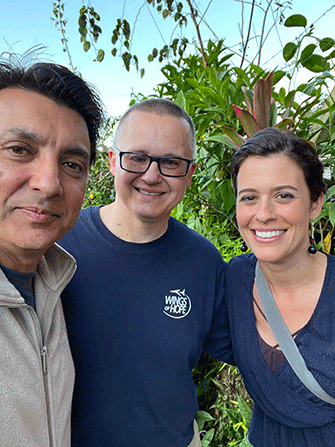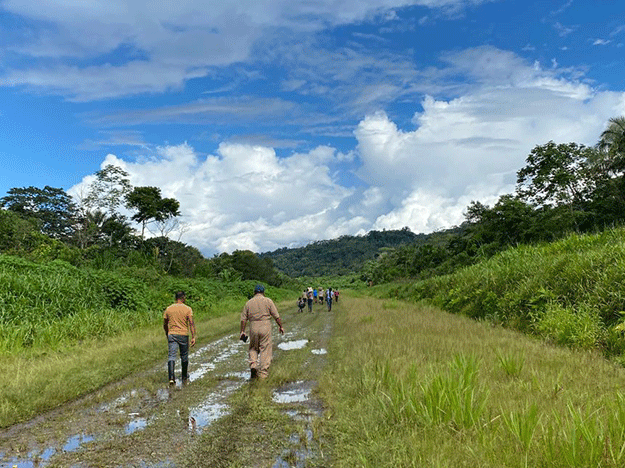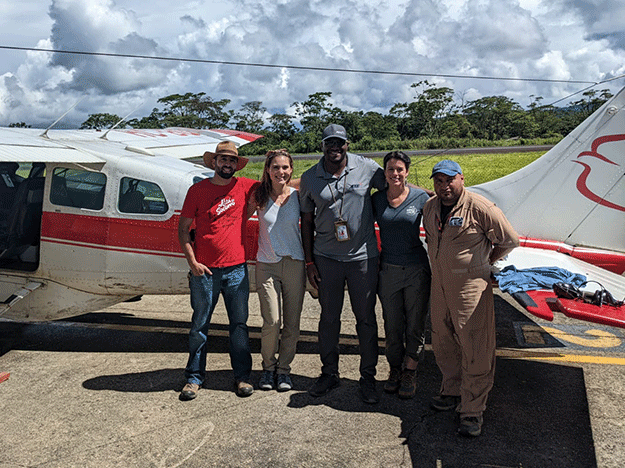Imagine if your ability to receive emergency medical care was dependent on the weather. That is all too often the case for communities in the Ecuadorian rainforest served by Wings of Hope partner Alas de Socorro (ADS).
Due Diligence Mission
This past May, a Wings of Hope team, including Director of Programs and Evaluation Tiffany Nelson, visited the field site which is based in Shell, Ecuador, on a due diligence mission to lay the groundwork for a new project using Unmanned Aerial Vehicles (UAVs), commonly known as drones, to complement the medevac flights ADS currently provides.
“What we learned is that it is VFR (visual flight rules) landings only which means if it is cloudy or rainy, they cannot land on these runways,” says Tiffany.
“This means sometimes patients will have to wait a day or two or even three — especially during rainy season — for assistance. That is one of the main motivators for the UAV program: when there is an emergency call, if we can’t get to them physically, then we can at least send medications with a UAV.”

“Elsa has done an incredible job project planning hand-in-hand with Marcos,” says Tiffany. “With her experience as a UAV instructor and also in community development, she really helps guide the team.”
Tiffany arrived in Ecuador about a week after Elsa. She partnered with Jose Arce, ADS country director, on a community analysis trip to better understand existing resources and community goals.
“Jose and I went directly to the clinics in each community,” says Tiffany. “We spoke to the doctors and nurses there about the community health priorities and what they’re experiencing as health care professionals.”
Emergency medicine is the top priority.
“We also spoke with community leaders to understand their high-level priorities,” she says. “They were receptive to the concept as they understand the challenges of flying in a Cessna 206 — especially during bad weather.”
Three Pilot Communities
Wings of Hope and ADS plan on piloting the drone program in three communities: Moretecocha, Tonampare and Numbaimi. They chose these communities “because they’re the centers of their communes,” says Tiffany, which means seven to eight smaller communities come to them for resources.
“Just working in that one community means we’re giving access to several other communities from the entire commune,” Tiffany explains.
With about 4,000 people living in each commune, the 18-month pilot program has the ability to improve access to emergency medicine for over 12,000 people.
The pilot communities also were selected for their location: southeast from Shell near the Peruvian border which is the area of highest need in the Pastaza region.
“Right now, if conditions do not allow for manned flying, in order for people to access emergency medications they have to make a full day’s walk to the river and then a full day’s river ride in a dugout canoe to get to the hospital,” Tiffany says. “It’s a multi-day trip.”
Snakebites and Emergency Medicine
Two of the most common uses for the drones will be delivering antibiotics to treat wounds and infections and antivenom to treat snake bites. ADS receives 80-100 snakebite calls each year in the Pastaza region alone.
The project calls for three drones launching from the ADS hangar in Shell and one stationed at Shell Hospital.
“ADS can store basic medical supplies; however, they can’t store antivenom and antibiotics. Those must be stored at the hospital,” says Tiffany.
In a typical snake-bite scenario, someone from one of the pilot communities would use a high-frequency radio (there is scant cell phone coverage) to call ADS and ask for antivenom. ADS would then contact the hospital in Shell, and they would load the medication into the capsule and launch the drone from there.
Building a More Economically Sustainable Program
Currently, ADS provides medevac flights in response to emergency calls from communities. But resources are limited, and flights are expensive — costing upwards of $500 per transport.
“We’re working on creating a more economically sustainable program using UAVs to complement the existing medevac program,” says Tiffany.
Helping more people by using drone technology has been a longtime goal of ADS.
“When you get a call from a patient and you don’t have another way to access them, it’s really tough on the family and ADS team,” says Tiffany. “This will give the community hope whenever the plane can’t fly in.”
Spirit of Collaboration
While Elsa and Marcos were completing site surveys and Tiffany and Jose were collaborating on the project with community leaders, Wings of Hope President and CEO Bret Heinrich and board member Manish Kohli were meeting with physicians at Shell Hospital and around the region to better understand the role Wings of Hope and ADS might play in strengthening health care for indigenous peoples.
“What we heard loud and clear from the people of the rainforest was that they want to live and thrive in their communities,” says Bret. “Leaving the rainforest for health care or for other needs can sometimes be a scary proposition. The interventions we are developing in Ecuador with our partner Alas de Socorro and Shell Hospital — and many other stakeholders — will promote healthy living in the rainforest by indigenous people.”
And the indigenous communities are at the center of the project planning.
“This pilot program truly embodies the collaborative spirit we’re aspiring to throughout our global humanitarian network, working hand in hand with our partners to build sustainable programming that empowers communities,” says Tiffany.
“It is a model for other field sites.”


